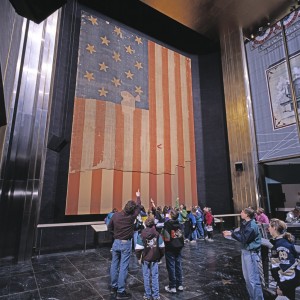 200 years ago today, a young lawyer wrote a love poem to a patchwork of colored wool and cotton. Could he have imagined that his poem would be sung by millions and ultimately, become the anthem of our nation?
200 years ago today, a young lawyer wrote a love poem to a patchwork of colored wool and cotton. Could he have imagined that his poem would be sung by millions and ultimately, become the anthem of our nation?
In 1814 the United States of America was engaged in the Second War of Independence – the War of 1812 – fought over promises made, but not kept, by the British after the Revolutionary War. As part of that conflict, on August 24th, 1814, the British invaded Washington DC and burned the White House, the Capitol Building and the Library of Congress.
One week later, Francis Scott Key, a 35-year-old lawyer and amateur poet, rowed out in a little boat to a British Naval vessel anchored off Baltimore to negotiate the release of Dr. William Beanes who had been captured during the Washington raid. The two were detained on ship for over a week to keep them from warning the Americans of the planned attack on strategic Fort McHenry.
For 25 horrific hours, 16 British warships relentlessly bombed the fort, stopping only when ammunition finally ran out. Key and Beanes paced the deck all night. At dawn on September 14, 1814, exactly 200 years ago today, they strained through the mist and smoke to answer the question burning in their hearts, “Is our flag still there?”
The stirring sight of that grand symbol of victory and freedom marked a turning point in the war (just 3 months later, the British signed a peace agreement), and inspired Key to scribble the first verse of his love poem on the back of a letter.
The 36 x 40 foot garrison flag Key saw by the dawn’s early light was sewn in the summer of 1813 under the direction of widow Mary Pinckersgill by 4 teenage girls: her daughter, two nieces, and an African American indentured girl. The commander of Ft. McHenry commissioned the flag, knowing that his fort, guarding Baltimore harbor, would be a likely British target.
Despite most myths about Old Glory – including the famous tale of Betsy Ross – which arose many years after the first war of independence, the American flag did not play a major role in the Revolutionary War. The American flag was created primarily to identify ships and forts. Revolutionary patriots used other symbols—the eagle, Lady Liberty, George Washington— to define their national identity. The War of 1812 inspired a fresh wave of patriotism in the hearts of a generation too young to remember the Revolution which occurred 30 years earlier. Key’s declaration that “our flag was still there,” fused the physical symbol of the nation with universal feelings of patriotism, courage, resilience, national identity, unity, and pride. And by giving it a name—the Star-Spangled Banner—he transformed the official emblem into something tangible that Americans could rally around.
Congress made “The Star-Spangled Banner” our official national anthem on March 3, 1931 – 116 years after it was written.
New York stockbroker Eben Appleton inherited the original Star-Spangled Banner upon his mother’s death in 1878. The publicity it received in the 1870s had transformed it into a national treasure. Appleton freely lent it out for patriotic occasions. The flag’s deteriorating condition eventually led him to keep it in a safe-deposit vault in New York. In 1912 he gave the Star-Spangled Banner to the Smithsonian National Museum of American History (check out the interactive flag feature at this site) with the wish that it would always be on public view. A previous post, His Star-Spangled Banner Over Us is Love, highlighted some of the stirring, godly content of our national anthem.
Young Francis Scott Key probably didn’t aspire to write our national anthem, he was simply responding to life as God presented it to him. Each day, the Thinking Christian Woman can ask herself, “What can I do today for Christ and His kingdom that will bless others and stand the test of time and eternity?”
© 2014 Melody K. Anderson All Rights Reserved





